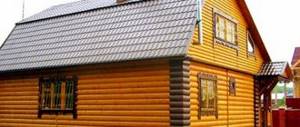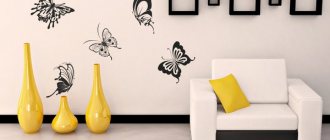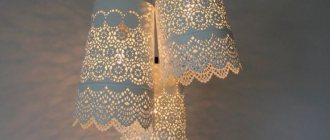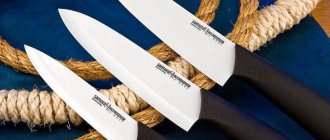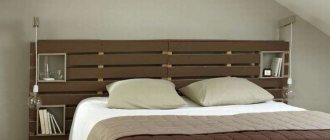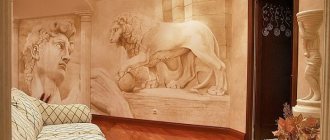With the help of curtain rods we attach curtains to the walls or ceiling. This is the main method of fastening and the most convenient. This method was used in ancient times in Egypt, which is why cornices similar to ancient Egyptian ones are now highly valued. Convenient because with the help of rings threaded into the rod, you can easily move aside tulle or curtains. There is no need at all, like in the good old days, to pull them with all your might so that they come off. It is important that it matches your interior more in style than in color. First, let's look at their types: profile, baguette, round, forged and string.
Wall-mounted wooden curtain rods: selection criteria
The most popular type are wall cornices. As a rule, rods of this type are made from coniferous and deciduous trees, but exotic species, such as mahogany or rosewood and others, are considered the most expensive. It cannot be said that any type of wood is the most durable. Everyone has different density, color, sensitivity to weather conditions.
It is better to choose according to the criteria that are most sensitive in your home. Such cornices have a practical and decorative function. The practical one is a clamp on a wooden sword. In this case, you will have to focus on the curtains.
The decorative factor includes decorations on sword tips. By the way, the buyer can choose the shape of the tip himself. Most often they are universal, for example, plants, animal figures, sculptures or something according to your sketch.
All this is thanks to wood carving, since wood is the most convenient material for such work. This is a very powerful fastening, because it can withstand even the heaviest fabrics.
Beautiful DIY curtains from sheets
When choosing fabric for a curtain, you must be guided by the room for which it will be used. Bright and cheerful colors, appliques, fairly large floral patterns, images of animals and fairy-tale characters are suitable for a children's room.
Curtain pattern drawing.
For the bedroom, it is best to give preference to calm shades and soft patterns. Bright colors are suitable for the kitchen, creating the necessary mood. Thick tree branches can be used as a cornice for such curtains. This decoration element is ideal for country style.
You need to decide on the size and mounting option on the cornice. The following can be used as fasteners:
- rings or clothespins that will be attached to the top of the fabric;
- fabric loops, which are sewn to the curtain with one part and secured with Velcro tape with the other;
- The upper edge of the curtain can be folded up and a solid pocket can be made on top through which the curtain rod will be threaded.
Any convenient option is chosen, it depends on the design features of the cornice. Even at the planning stage, you need to decide whether decorations will be used, that is, tassels, fringe, etc. Since the curtain will be sewn from a sheet, it is best to use applique, large and beautiful buttons.
Article on the topic: Cross stitch technique: for beginners, execution, video and safety, step-by-step rules, production with photos
Step-by-step instruction
The sewing process itself is as follows:
An example of a pattern for a classic curtain with a lambrequin.
- First you need to take measurements of the cornice and window opening, determine exactly what length is needed for the future curtain. Often at this stage it turns out that one sheet is not enough; it is best to use 2-3 so that the curtain forms beautiful and neat folds.
- After this, all the tools for work and curtains are prepared. You should start sewing on a table that is level and free from foreign objects. All the necessary accessories are placed right next to it so as not to interrupt the process during work.
- First you need to rip all the seams. This work is easy, but it takes a lot of time, you need to be prepared for it.
- The diameter of the cornice is measured if a pocket or loops will be made for fastening. In the first case, you need to consider how long it will be necessary to wrap the fabric, and in the second, prepare pieces of fabric or tape that will be needed for sewing loops.
- To make a pocket, add 7 mm to the diameter, fold the fabric and sew it to the main fabric. If 2 or more sheets will be used, then they must first be sewn together, after which you can start processing the seams on 3 sides.
- If loops made from ribbons are used, you need to sew one side of them to the top edge of the fabric, then fold it over and sew a neat seam. Pieces of Velcro tape are sewn onto the other part of the tapes and onto the base of the loops, with the help of which the loops will be attached. You can also use beautiful buttons for this; in this case, they can go to the front side, creating an unusual decoration.
- All seams are carefully ironed, the curtain fabric is ironed, after which it can be hung on the window.
Ceiling cornices made of wood: what to look for
Such cornices have more of a decorative function than a practical one, since they are much more noticeable than wall ones. This element of decor can no longer be hidden, and indeed it is not necessary. With the right choice of wood and color, it will complement the curtains perfectly. For this type of carving, wavy lines are considered universal carvings. They are often confused with profiles. Unlike wall cornices, functional mechanisms are completely hidden in ceiling cornices.
The importance of cornices is as great for the interior as for other components. what to look for when choosing, read on the website:
There are also other advantages over wall-mounted ones, for example, the following: fasteners can be three-row, the choice of design for such fastenings is huge. However, they can hardly be called budget.
The high cost is due to the exquisite carving and massive material. This design is most likely suitable for draped curtains, as well as heavy dark fabrics. If you want to emphasize your high income, then it is better to choose mahogany ceiling cornices. Products made from oak are considered more restrained. If, on the contrary, you need to save money, then it is better to choose products made from pine or alder. In some cases, they even emit a pleasant forest smell.
How to make a curtain with your own hands?
Curtains are usually a rectangular piece of fabric with finished seams. No special knowledge is required, you just need to be able to handle a thread and a needle, and have basic skills in working with a sewing machine.
First you need to choose the fabric and model of the curtain. It is generally recommended to choose lightweight or medium weight fabrics that will fit nicely into folds. Color and texture depend entirely on what kind of interior is furnished. For a minimalist style, plain fabrics or with a strict geometric pattern are suitable; the color can be any color that matches the setting.
For a modern high-tech style, fabrics chosen are silver, gray, white, soft, and austere. For the kitchen you can use bright shades, stripes, floral patterns, applications in the form of fruits and vegetables are welcome . But pastel, calm colors are suitable for the bedroom; excessive drawing is not needed.
Calculation of fabric for curtains.
After the fabric is selected, it is necessary to take measurements of the window opening and determine the length of the future curtain. After this, you need to decide on the future form. The canvases have the shape of a rectangle; no special wisdom is required for the pattern.
To make a curtain with your own hands, you should immediately prepare all the materials and tools that will be needed during work:
- sewing machine;
- threads and needles, scissors;
- metal long ruler;
- a piece of soap or a special chalk;
- soft measuring tape;
- curtain tape that will be sewn on top for assembly;
- curtain fabric of the chosen color.
Cutting is carried out only on a flat surface, according to previously determined sizes and shapes. For this, a metal ruler, chalk, measuring tape, and pattern are used. The fabric is carefully cut, leaving 5 cm on each side for finishing the seams. During work, you must constantly check that all sizes and shapes are respected, otherwise the curtain will turn out skewed and not so neat.
Related article: DIY polycarbonate gazebo drawings: choosing the shape and method of construction
Tips for choosing carved wood cornices
When choosing carved wooden cornices, you should pay attention not only to the design and design of the accessory itself, but also not to forget about the overall design of the room: it is not quite easy to choose a wooden cornice for every interior style.
Here are some tips for choosing carved cornices:
- Cornices must necessarily match the overall design of the room. There is no need to buy an expensive, luxurious cornice for a modest room. It will look stupid. Or the choice will be considered unsuccessful when the room has a modern style, and cornices with exquisite carvings made of dark wood, which are suitable only for the Baroque style.
- The weight of the fabric is of great importance. When purchasing, it is better to check the durability of the fabric in advance, since now it is more fashionable to choose heavy, opaque fabrics. If you miss this nuance, the cornice may simply collapse and break, sometimes without even a chance of repair.
- It is best to choose double rows. You will hang tulle on the first row, and a curtain on the second. There is no need to hang both fabrics on the same row, because of this the textiles often tear and the elements of its fastening break off. In addition, it will be inconvenient to open and close the curtains.
- If you don’t like that you have a small window, then you can choose long rods that will cover part of the walls. This visually enlarges the windows. You can also hang ceiling cornices, they also enlarge the window. With these methods, your guests most likely will not notice this secret.
- If there are a lot of elements on the cornice, then it is better to play it safe and buy a lot of fasteners. A small number of fasteners may cause you to accidentally injure yourself.
Which cornice to choose so that it matches the style and modern requirements? The answer is in our next article:
Guided by simple criteria and selection tips, you can choose a worthy accessory for the interior of your room.
DIY wooden cornice: do it step by step
For a capricious owner, it is best when he makes the cornice himself with his own hands. Especially if you have not only an idea, but also good materials, and most importantly a little patience. On the Internet you can look at photos from which you will build. To create a practical cornice you will need less materials and physical effort. For a practical frame, you only need a barbell, rings, fasteners and tips.
And if you want to hide the cornice mechanism, then a baguette cornice will help you. Read about it in the following article:
Below are the approximate stages of creating a decorative wooden cornice, but they are individual for everyone:
- Make the sides of any shape you like;
- Drill holes in the sides;
- Attach hangers (it’s best to take metal ones);
- Using a jigsaw, cut out the bottom shape to your liking;
- Sand the remaining parts of the cornice;
- Coat with varnish of the color you like (if the wood has an uneven color, or you can coat it with a wood preservative);
- It is best to leave everything to dry well in the sun for 24 hours;
- First fix the decorative parts;
- Then attach them to the ceiling or wall using self-tapping screws.
If you want to hide the fasteners, paint them over or attach a decorative piece.
Homemade cornices
This accessory is quite easy to make with your own hands. In this case, such a decision can most often be made not because of the cost of the finished product, but rather because of the desire to create a unique thing. At the same time, in terms of practicality and functionality, homemade models are in no way inferior to purchased analogues.
For the simplest model, you will need to assemble a U-shaped box from small slats, but you will have to additionally purchase fastening elements for curtains in the store. The strips on the box can be decorated with decorative carvings or some kind of pattern.
To make another model with your own hands, you can use a regular handle from a shovel or rake. It will need to be varnished and secured above the window opening. When using such curtain rods, you can use rings, preferably wooden ones, to 2902 fasten curtains. The edges of such a product can be decorated with additional cone-shaped elements.
When decorating a window opening in a country house, it all looks very attractive. You can make this accessory from any available means, in this case, everything is limited only by the completeness of your imagination. At the same time, a handmade product will delight the eye and warm the soul from the fact that you independently decorated the interior of the room, without resorting to the help of designers.
Design of wooden curtain rods (interior photo)
- Author: admin
Rate this article:
- 5
- 4
- 3
- 2
- 1
(2 votes, average: 3 out of 5)
Share with your friends!
Curtain braid
It is also called the Austrian ribbon. It is necessary to tighten the fabric and obtain uniform drapery of the desired pomp. For, and a transparent tape with an allowance on 2 sides of 6-8 cm, a width of 2.5-8 cm is suitable. A short curtain looks more beautiful when using a narrow braid. In any case, the tape should be loose and hold its shape when the laces are pulled together. The wide ribbon has 2 rows of loops, which allows you to change the height, hang the curtain lower or higher. The wider the ribbon, the more options for draperies and folds you can create. How to sew ribbon for curtains with your own hands? The braid allowances are folded inwards and the lace is released. The tape is adjusted from the wrong side, retreating 1-2 mm from the top edge so that it is not visible. And if you want to hide the rings or cornice with a curtain, the braid is lowered 2-5 cm from the edge. The braid is attached first from the top, then from the bottom. If it has more than 2 laces, then lines are also laid along them.
You may also be interested in: DIY Japanese curtains
How to assemble a curtain? It is better to tighten the tape on both sides at the same time, moving the fabric from the edge to the middle. The laces must be tied with a loose knot. The curtain is pulled to the desired width, after which the folds are evenly distributed. The laces are not cut, they are untied and the fabric is straightened before washing. To prevent them from hanging down and spoiling the look of the curtains, they are carefully rolled up and attached to the braid with a pin. After this, the curtain can be hung on a cornice, which can be part of the window decor. Often the fastening mechanism is hidden in a niche in a multi-level ceiling or behind a molding. The most popular type of fastening is hooks. They are placed at a distance of 8-12 cm from each other.
No drapery
The basic principle of the modern method of window design “minimalism” is the absence of folds and gathers. Curtains with loops (patches), which are made from ribbons, braid in a contrasting color or from curtain fabric, look stylish. It doesn't need hooks. The loops can be fastened with buttons, snaps, Velcro, or tied with bows on the curtain rod. If it can be easily removed, the patches can be sewn without unfastening. You should first check how easily the fabric will move along the cornice. The width of the fabric for it should be 1.5 times larger than the window opening. The side sections are processed as stated above, the corner joints are sewn together with a hidden seam. The simplest option is to sew curtains on “blind” loops. Their width and length are chosen arbitrarily. The required allowance is 2 cm. The number of loops is calculated based on the fact that the distance between them should be 2 times their width. The strips for them are folded lengthwise with the right side inward, stitched, turned inside out, ironed and pinned to the top edge of the main fabric turned 2 cm. After this, the loops are adjusted with some kind of braid or fabric facing.
You may also be interested in: Patterning and sewing a “butterfly” lambrequin with your own hands
Curtains look elegant on grommets - holes edged with metal or plastic in the fabric with an internal diameter of 1.5-5 cm. Round fittings are in greatest demand, although they can be square, triangular, or in the shape of flowers. In addition, eyelets are selected by color: plain, transparent, wood texture. Their internal diameter should be at least 1.5 cm larger than the diameter of the cornice. Metal eyelets are installed only in special workshops using a press. Although they look impressive, they often rust after washing and damage the fabric. Plastic fittings are installed at home. How to make a curtain with eyelets yourself? The bottom and sides of the curtain are processed in the usual way; the upper part must be sealed, otherwise the fittings will not stick to the fabric. For light curtains, use a transparent duplicating grommet tape 2-3 cm wider than the outer diameter of the elements, the number of which must be even, otherwise one of the side seams will always turn towards the room. Markings are made on the sewn curtain, holes are cut into which the eyelets simply snap into place.


